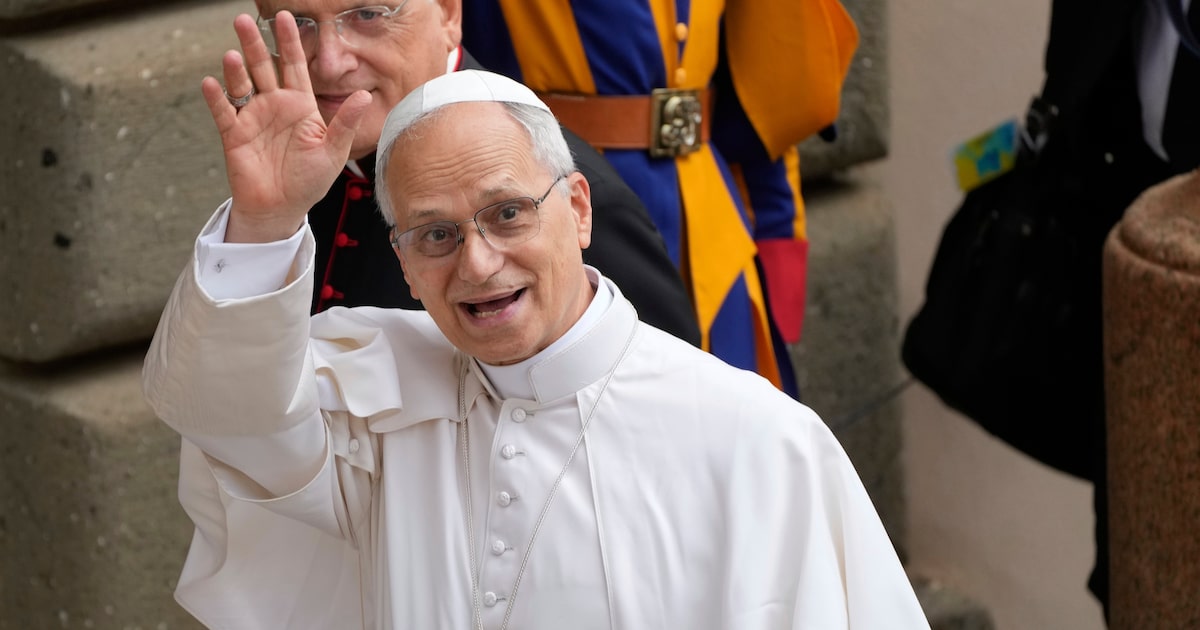On Saturday, June 7, a group of five members of the SMU community was present for a historic private audience with the first American pope in Rome.
The sun had risen across the Eternal City in a golden burst of light that made the urban landscape gleam, and the emerald waters of the ancient Tiber were calm but for a few ripples along its shores. Our instructions were to be at Porto del Perugino promptly at 9:30 am. Located along the southern walls of the Vatican, just a block from Via Aurelia on the non-touristy side of St. Peter’s Basilica, it is an entry used for official visits.
A quarter century earlier, I’d attended a public audience of Pope John Paul II with a few thousand visitors at Paul VI Audience Hall, a space that accommodates up to 6,000 pilgrims; and shortly after that, a consistory to elevate cardinals like the late Avery Cardinal Dulles, son of former U.S. Secretary of State John Foster Dulles, whom I got to share a few words with in February 2001. Now, three popes later, we were about to be received in a private audience with Leo XIV, the first American pope, at a historic encounter that few of those in attendance could have imagined.
The private audience was granted to an organization called the International Orthodox Theological Association (IOTA), which had co-organized a theological conference with the Institute for Ecumenical Studies of the Angelicum in Rome. The conference, “Nicaea and the Church of the Third Millennium: Towards Catholic-Orthodox Unity,” had been organized to commemorate the 1700th anniversary of the famed Council of Nicaea, which helped shape Christian doctrine.
Convened by Emperor Constantine and presided over by Bishop Hosius of Córdoba, the Council of Nicaea was held between May and August in AD 325 in the city of the same name, in present day İznik, Turkey. One of the most significant church councils, it resulted in several outcomes, including the Nicene Creed, which articulated a statement on the nature of Jesus Christ, and the establishment of a unified date for Easter. This latter point eventually diverged due to how the Western Church followed the Gregorian calendar, while the Eastern Church remained with the more traditional Julian calendar.
Now, in 2025, we were there with another pope in a gathering smaller than the one in Nicaea. A private audience is not 6,000 people but anywhere from a single individual to a group of around 200. The IOTA Conference attendees included individuals from Orthodox, Catholic and Protestant traditions, representing a swath of global Christianity.
We were led near the Vatican gardens, past the Sistine Chapel, and through Renaissance-era passageways into the San Damaso Courtyard of the Apostolic Palace.
We ascended four flights of an imperial staircase while waiting for the papal butlers to open the Sala Clementina. This resplendent hall is decorated from floor to ceiling in frescoes by the illustrious brothers Giovanni and Cherubino Alberti and is reserved for state visits and other official duties.
We all found our seats and waited for the audience to begin. A few rooms away, Javier Milei, the president of Argentina, was having his first audience with the pope. At 11:09 a.m., Leo XIV entered the hall to joyous applause and greeted members of the delegation. Among them were IOTA founder and president Paul L. Gavrilyuk, who was personally welcomed by the pope. Gavrilyuk presented the pontiff with a copy of The Oxford Handbook of Deification, which he co-edited. Other SMU alumni included Justus Hunter, sssociate professor at United Theological Seminary; David F. Watson, president of Asbury Theological Seminary; and Sergei Nikolaev, president of Moscow Theological Seminary of the United Methodist Church. Each of the SMU graduates had studied at Perkins School of Theology and the Graduate Program in Religious Studies at SMU with the late William J. Abraham, who was involved in many important theological conversations with the Orthodox Church.
When the pope finally addressed the group, he joked by saying he was just one month on the job and asked for our patience. His kind welcome, soft but steady voice, and overall presence brought a sense of calm upon us all.
He spoke meaningfully about the various themes of the Nicaea Conference and IOTA and, in a significant moment, stated that the Catholic Church was open to an “ecumenical solution favoring a common celebration” of Easter. An historic moment indeed.
My SMU colleagues and I, sitting together, felt the weight and importance of the private audience, and knew it was likely a once in a lifetime experience that we would carry with us always.
Pope Leo XIV left the group with a prayer and a blessing and a message of unity. And in that papal gallery within the Apostolic Palace that early June morning, SMU was humbly represented by its own community and had a chance to witness a significant moment in the history of the universal church with the first American pope.
Anthony J. Elia is the director of the Bridwell Library at Southern Methodist University.
